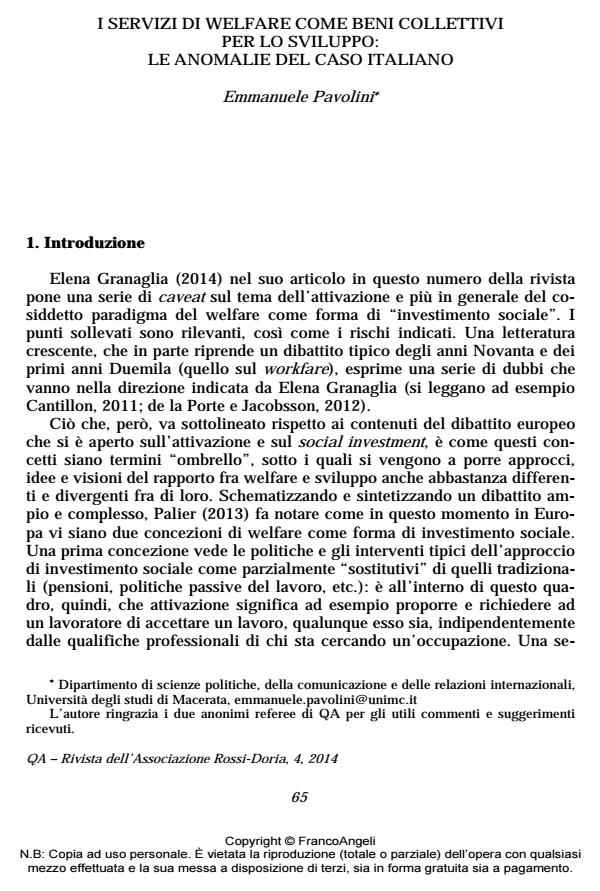Welfare State Services as Collective Goods for Economic Development: Italian Anomalies
Journal title QA Rivista dell’Associazione Rossi-Doria
Author/s Emmanuele Pavolini
Publishing Year 2015 Issue 2014/4 Language Italian
Pages 23 P. 65-87 File size 94 KB
DOI 10.3280/QU2014-004004
DOI is like a bar code for intellectual property: to have more infomation
click here
Below, you can see the article first page
If you want to buy this article in PDF format, you can do it, following the instructions to buy download credits

FrancoAngeli is member of Publishers International Linking Association, Inc (PILA), a not-for-profit association which run the CrossRef service enabling links to and from online scholarly content.
The essay analyzes social investment strategies in Italy at the regional level. Italy is increasingly characterized by the presence of two welfare systems, one (in the Centre-North) in which social investment strategies integrate traditional welfare schemes and support local economic development, the other (in the South) in which the shortcomings of the traditional welfare state are matched by poor development in social investment strategies. In no other Western European country is the relationship between the level of local economic development and the diffusion of social investment strategies so marked. EconLit Classification: I380, O100
Keywords: Social investment, Local development, Territorial inequalities, Territorial divides, Italy
- Ballarino G. (2015), «School in Contemporary Italy. Structural Features and Current Policies» in Ascoli U., Pavolini E. (eds.), The Italian Welfare State in a Comparative Perspective, Policy Press, Bristol, pp. 135-157.
- Barca F. (2006), Italia frenata: paradossi e lezioni della politica per lo sviluppo, Donzelli, Roma.
- Ocse (2014a), Socx Database, Ocse, Paris.
- Ocse (2014b), Ocse-Pisa Database, Ocse, Paris.
- Palier B. (2013), «Social Policy Paradigms, Welfare State Reforms and the Crisis», Stato e Mercato, 97, pp. 37-66.
- Pavolini E. (2011), «Welfare e dualizzazione dei diritti sociali», in Ascoli U. (a cura di), Il welfare in Italia, il Mulino, Bologna.
- Pavolini E. (a cura di) (2012), Il cambiamento possibile. La Sanità in Sicilia fra Nord e Sud, Donzelli, Roma. Pierson P. (ed.) (2001), The New Politics of the Welfare State, Oxford University Press, Oxford.
- Ranci C., Ascoli U., Sgritta G. (a cura di) (2014), Le politiche di investimento sociale in Italia, il Mulino, Bologna, in corso di stampa.
- Ranci C., Pavolini E. (a cura di) (2012), Reforms in Long-Term Care Policies in European Countries, Springer, New York.
- Taylor-Gooby P. (ed.) (2004), New Risks, New Welfare: The Transformation of the european Welfare State, Oxford University Press, Oxford.
- Trigilia C. (2012), Non c’è Nord senza Sud. Perché la crescita dell’Italia si decide nel Mezzogiorno, Laterza, Bari.
- Vesan P. (2012), «La politica del lavoro», in Ferrera M. (a cura di), Le politiche sociali, il Mulino, Bologna, pp. 113-169.
- Nikolai R. (2012), «Towards Social Investment? Patterns of Public Policy in the Oecd World», in Morel N., Palier B., Palme J. (eds.), Towards a Social Investment Welfare State?: Ideas, Policies and Challenges, pp. 123-154.
- Natali D. (2011), «Le politiche pensionistiche», in Ascoli U. (a cura di), Il Welfare in Italia, il Mulino, Bologna, pp. 57-78.
- Morel N., Palier B., Palme J. (eds.) (2012), Towards a Social Investment Welfare State?: Ideas, Policies and Challenges, Policy Press, Bristol.
- Kazepov Y., Barberis E. (a cura di) (2012), Il Welfare frammentato, Carocci, Roma.
- Kazepov Y. (a cura di) (2010), Rescaling Social Policies, Ashgate, Farnham.
- Istat (2014b), Istat – Health for All database, Istat, Roma.
- Istat (2014a), Indicatori per le politiche di sviluppo, Istat, Roma.
- Hemerjick A. (2013), «When Changing Welfare States and the Eurocrisis Meet», Sociologica, 1, pp. 1-50.
- Heckman J.J., Masterov D.V. (2007), «The Productivity Argument for Investing in Young Children», Review of Agricultural Economics, 29, 3, pp. 446-493.
- Granaglia E. (2014), «Welfare state e crescita. Oltre la visione attivante delle politiche sociali», QA – Rivista dell’Associazione Rossi-Doria, 4, pp. 13-36.
- Ferrera M. (2008), «Dal welfare state alle welfare regions», Rivista italiana delle politiche sociali, III, pp. 17-50.
- Fargion V., Gualmini E. (a cura di) (2013), Fra l’incudine e il martello. Regioni e nuovi rischi sociali in tempo di crisi, il Mulino, Bologna.
- Fargion V. (2000), «Timing e sviluppo dei servizi sociali in Europa», Rivista italiana di scienza politica, I, pp. 45-85.
- Eurostat (2014), Eurostat Statistics Database, Eurostat, http://epp.eurostat.ec.europa.eu/.
- Eurobarometro (2007b), Survey n° 62.2, Eurobarometro.
- Eurobarometro (2007a), Survey n° 66.3, Eurobarometro.
- Esping-Andersen G. (2009), The Incomplete Revolution: Adapting to Women’s New Roles, Polity Press, Cambridge, Ma.
- Destatis (2009), «Kinder unter 6 Jahren in Kindertageseinrichtungen», Pressemitteilung, 409.
- Palier B., Palme J. (eds.), Towards a Social Investment Welfare State?: Ideas, Policies and Challenges, pp. 231-254.
- de la Porte C., Jacobsson K. (2012), «Social Investment or Re-Commodification? Assessing the Employment Policies of the EU Member States», in Morel N.,
- Cdaia (2002), I servizi educativi per la prima infanzia, Istituto degli Innocenti, Firenze. Cersosimo D., Nisticò R. (2013), «Un Paese disuguale: il divario civile in Italia», Stato e Mercato, 98, pp. 221-247.
- Cantillon B. (2011), «The Paradox of the Social Investment State: Growth, Employment and Poverty in The Lisbon Era», Journal of European Social Policy, 21, 5, pp. 432-49.
- Cannari L., Franco D. (a cura di) (2010), Il Mezzogiorno e la politica economica dell’Italia, Banca d’Italia, Roma.
- Brandolini A., Torrisi R. (2010), «Disuguaglianza dei redditi e divari territoriali», Rivista delle politiche sociali, 3, pp. 27-54.
Emmanuele Pavolini, I servizi di welfare come beni collettivi per lo sviluppo: le anomalie del caso italiano in "QA Rivista dell’Associazione Rossi-Doria" 4/2014, pp 65-87, DOI: 10.3280/QU2014-004004